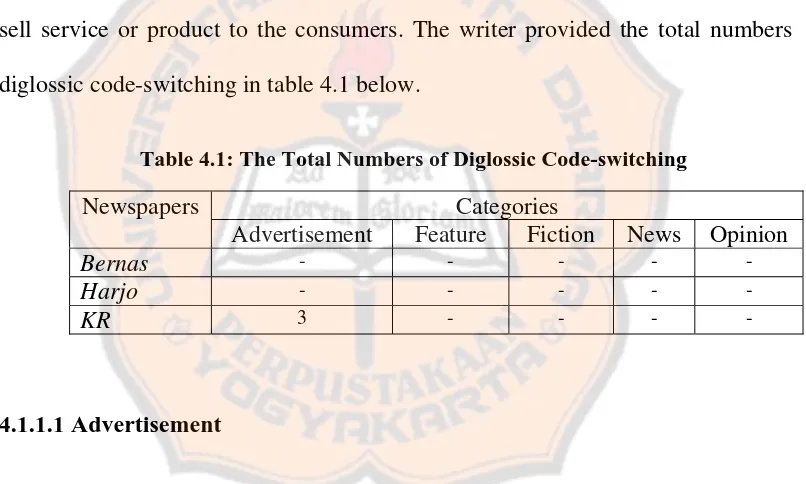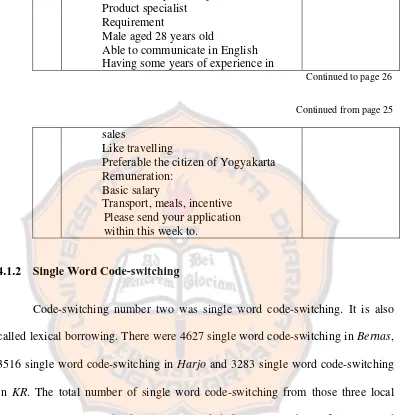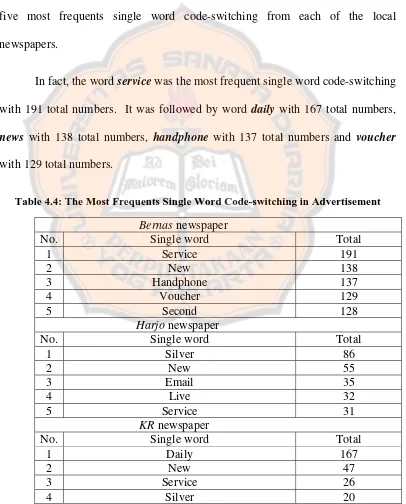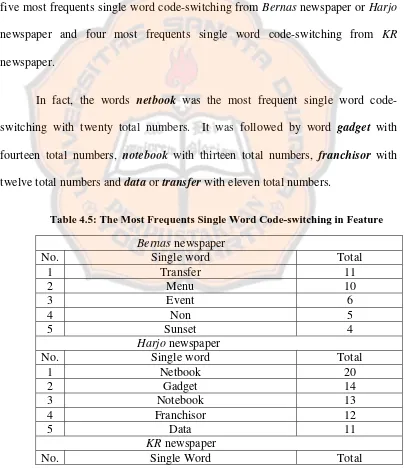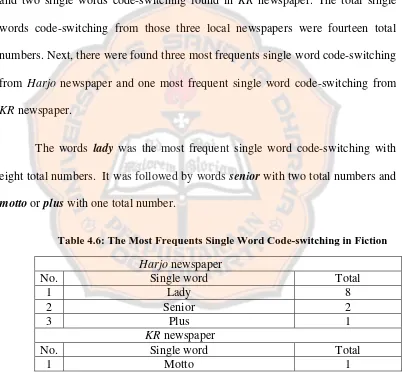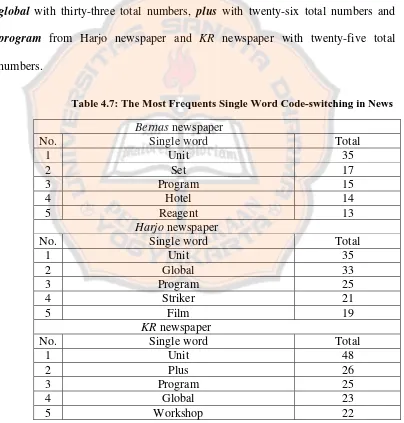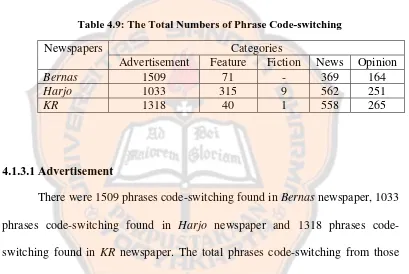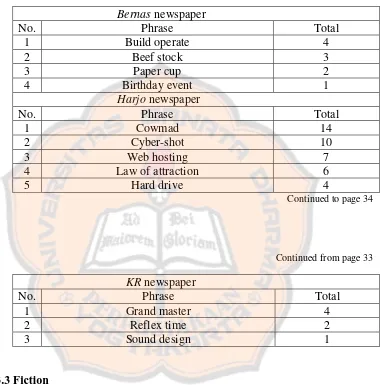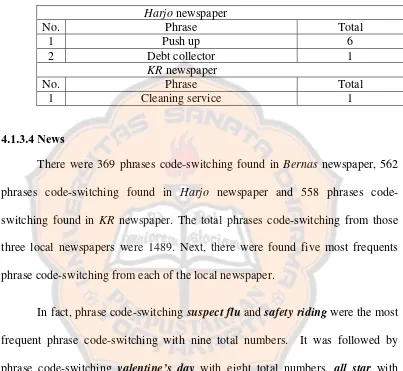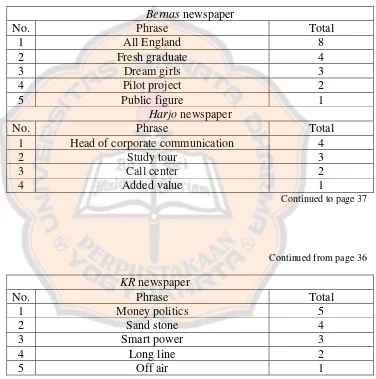ENGLISH CODE-SWITCHING IN INDONESIAN LOCAL NEWSPAPERS
A Thesis
Presented as Partial Fulfillment of the Requirements to Obtain the Sarjana Pendidikan Degree
in English Language Education
By
Room Mawardi Yohanes Student Number: 051214083
ENGLISH LANGUAGE EDUCATION STUDY PROGRAM DEPARTMENT OF LANGUAGE AND ARTS EDUCATION FACULTY OF TEACHERS TRAINING AND EDUCATION
SANATA DHARMA UNIVERSITY YOGYAKARTA
i
ENGLISH CODE-SWITCHING IN INDONESIAN LOCAL NEWSPAPERS
A Thesis
Presented as Partial Fulfillment of the Requirements to Obtain the Sarjana Pendidikan Degree
in English Language Education
By
Room Mawardi Yohanes Student Number: 051214083
ENGLISH LANGUAGE EDUCATION STUDY PROGRAM DEPARTMENT OF LANGUAGE AND ARTS EDUCATION FACULTY OF TEACHERS TRAINING AND EDUCATION
SANATA DHARMA UNIVERSITY YOGYAKARTA
v
Dedicated to:
My beloved parents; Yoseph Mardjono & Theresia Satiyah
My lovely sisters; Cecilia Ismawarti & Elisabeth Hermi Prastiwi
My brother in-law; Yoseph Intoko
My little niece; Brigita Arleta Dharmaning Putri
When there is a will,
vii
ABSTRACT
Yohanes, Room Mawardi. (2009). English Code-switching in Indonesian Local Newspapers. Yogyakarta: Sanata Dharma University.
English elements often appear in many kinds of Indonesian local newspaper. Even, this phenomenon has become the essential part almost in every article of the newspapers. Sociolinguistics defined this phenomenon as code-switching. switching also happens in teaching learning activity. Code-switching can support and hinder language acquisition. The research was conducted to examine code-switching in Berita Nasional (Bernas), Harian Jogja
(Harjo) and Kedaulatan Rakyat (KR) newspapers.
This research had three questions to be answered. They were 1) what are types of code-switching found in Indonesian local newspapers? 2) what are the possible reasons for code-switching in Indonesian local newspapers? 3) what are the possible implications of code-switching in Indonesian local newspapers towards English education (teaching/learning) in Indonesia?
The writer conducted qualitative research to find the answer of the problem formulations. Document analysis was also applied as the type of qualitative research. The writer employed seven steps to answer those three problems, namely 1. specifying the phenomenon to be analyzed, 2. selecting the target from which the analysis is done, 3. designing the observation form, 4. listing the code-switching cases on the observation form, 5. analyzing the types of code-switching, 6. identifying the possible reasons for code-switching, 7. making implication based on the findings.
The writer found the answer of the first problem formulation; there were six types of code-switching found in Bernas, Harjo and KR newspapers, namely: diglossic, single word, phrase, clause, whole sentence and integrated loanword. Single word code-switching was the most frequent code-switching with 11.426 total numbers and diglossic code-switching was the least frequent code-switching with only three occurrences.
Next, the writer used Poedjosoedarmo’s theory on reasons for using code-switching. The writer found that there were 7 reasons for code-switching in local newspapers. They were the writer quotes from other language, the writer talks with the different interlocutors, there is a certain purpose from the writer, the writer is on the stage, the effect of topic discussion, the effect of the first sentence, the effect of conversation speaking situation. The third reason ‘there is a third person’ was not appropriate because there was no conversation between three or more persons in the newspapers. The writer only found the conversation between the interviewer and the respondent. In every conversation, there was only one respondent who spoke.
viii
might hinder language acquisition. However, the amount of incorrect code-switching was less than the correct one.
The writer would like to suggest that teachers should give the good basic of English knowledge to the learners. The learners will be able to distinguish between correct and incorrect code-switching they find, in this case in local newspapers.
ix
ABSTRAK
Yohanes, Room Mawardi. (2009). English Code-switching in Indonesian Local Newspapers. Yogyakarta: Universitas Sanata Dharma.
Elemen bahasa Inggris seringkali muncul di berbagai macam koran lokal berbahasa Indonesia. Bahkan, fenomena ini telah menjadi bagian penting hampir di setiap artikel dalam koran. Sosiolinguistik mendefinisikan fenomena ini dengan istilah code-switching. Code-switching juga terjadi dalam proses belajar – mengajar. Code-switching dapat mendukung dan menghambat penguasaan bahasa. Penelitian ini dilakukan untuk menguji code-switching di Berita Nasional
(Bernas), Harian Jogja (Harjo) dan Kedaulatan Rakyat (KR).
Ada tiga pertanyaan yang ingin dijawab dalam penelitian ini, yaitu: 1) tipe
code-switching apa saja yang ditemukan di koran-koran lokal berbahasa Indonesia? 2) alasan – alasan apa saja yang mungkin mendasari penggunaan code-switching di koran – koran lokal berbahasa Indonesia? 3) Implikasi – implikasi
code-switching seperti apa yang mungkin berhubungan dengan pendidikan bahasa Inggris (proses belajar/mengajar) di Indonesia?
Penulis menggunakan penelitian kualitatif untuk menemukan jawaban dari rumusan masalah. Analisa dokumen juga digunakan dalam riset ini sebagai tipe dari penelitian kualitatif. Untuk menjawab tiga rumusan masalah tersebut, penulis melakukan tujuh langkah penelitian, yaitu: 1. menentukan fenomena yang akan dianalisa, 2. memilih sasaran dimana analisa dilakukan 3.membuat lembar observasi 4. mendata kasus –kasus code-switching dalam lembar observasi 5. menganalisa tipe – tipe code-switching 6. mengidentifikasi alasan – alasan yang mungkin melandasi terjadinya code-switching 7. membuat implikasi berdasarkan pada hasil analisa.
Penulis menemukan jawaban dari pertanyaan pertama. Ada enam tipe
code-switching yang ditemukan di Bernas, Harjo dan KR yaitu: diglossic, single word, phrase, clause, whole sentence dan integrated loanword. Single word code-switching adalah code-switching yang paling sering muncul dengan jumlah total 11.426 dan diglossic code-switching adalah code-switching yang paling jarang muncul dengan jumlah total tiga.
Selanjutnya, penulis menggunakan teori 8 alasan dalam penggunaan code-switching dari Poedjosoedarmo. Penulis menemukan bahwa ada 7 alasan yang cocok dengan keseluruhan data, yaitu penulis menyitir kalimat lain, berubahnya lawan bicara, pengaruh maksud – maksud tertentu, bersandiwara, pengaruh topik pembicaraan, pengaruh kalimat yang mendahului, pengaruh situasi pembicaraan. Alasan ketiga yaitu ‘pengaruh hadirnya orang ketiga’ tidak sesuai dengan data karena tidak ada percakapan yang melibatkan tiga orang atau lebih dalam koran lokal. Penulis hanya menemukan percakapan antara pihak pewawancara dan responden. Dalam setiap percakapan tersebut, hanya ada satu responden yang berbicara.
x
banyak code-switching yang benar dan yang salah dari data keseluruhan. Code-switching yang benar mungkin dapat mendukung penguasaan bahasa dan code-switching yang salah mungkin dapat menghambat penguasaan bahasa. Bagaimanapun, jumlah code-switching yang salah lebih sedikit daripada jumlah
code-switching yang benar.
Penulis bermaksud menyarankan kepada para guru agar memberi dasar pengetahuan bahasa Inggris yang kuat kepada para murid. Murid – murid akan mampu membedakan antara code-switching yang benar dan salah, dalam kasus ini
code-switching yang mereka temukan di koran - koran lokal.
xi
ACKNOWLEDGMENTS
I would like to thank my beloved God, Jesus Christ for giving me every
chance in my life, including the chance to live. I thank Him for giving me
everything that I have and listening to all my complaints until this time. I also
would like to show my appreciation to those who had helped me.
I would like to thank F.X. Ouda Teda Ena, S.Pd., M.Pd., my sponsor who gave guidance for finishing my thesis during this semester. I really appreciate
his kindness and patience for waiting for me until I finished the thesis. It looked
impossible for the first time, but his words had made it true.
I would like to thank all lecturers and staff of the English Education Study Program for their help so far. I thank them for every precious experience I had during these four years. They had guided me to be what I have to be now.
I also would like to give my special thank to my parents, Yoseph Mardjono and Theresia Satiyah, who always support me whenever I am down. My other special thanks are dedicated to my sisters, Cecilia Ismawarti and
Elisabeth Hermi Prastiwi, for their cheerfulness in our small house. I thank my brother in-law, Yoseph Intoko, for lending his laptop so that I could finish my thesis on time. My warmest thank is to my little niece, Etta, who always gives the new spirit by her shouts.
Last, I express my thanks to all my friends in EESP. They are Fidel, Dee,
Vivi, Dhea, Koko and Nana as my partners in thesis and my classmates who have
xii
Agung, Dita, Tim-Tim, Yaya, Antris, Rindhang, Berlin, Taju, Mui, Angga, Sano,
Wuri, Frans Wuri, Pandu, Puri, Putri, Ari, Mega, Molen, Bunga, Rere and Toto. I
also thank Tata, Tyas, Tama, Septi, Nana, Bagus, Imel and Danu for helping me
to finish my thesis. However, I cannot mention one by one those who had helped
me. As I know, I am nothing without them. They all are my spirit.
Room Mawardi Yohanes
xiii
LEMBAR PERNYATAAN PERSETUJUAN PUBLIKASI KARYA ILMIAH UNTUK KEPENTINGAN AKADEMIS………. vi
xiv
3.4 Data Gathering Technique………. 20
3.5 Data Analysis Technique……… 20
3.6 Research Procedure………. 22
CHAPTER IV. RESEARCH FINDINGS AND DISCUSSION 4.1 The Types of Code-switching……… 24
4.1.1 Diglossic Code-switching..……….. 25
4.1.2 Single Word Code-switching………...…… 26
4.1.3 Phrase Code-switching………... 31
4.1.4 Clause Code-switching………. 37
4.1.5 Whole Sentence Code-switching.………... 41
4.1.6 Integrated Loanwords Code-switching………… 45
4.2 The Reason for Code-switching………...…. 50
4.3 The Implication of Code-switching……….…… 56
CHAPTER V. CONCLUSIONS AND SUGGESTIONS 5.1 Conclusions………...…...……. 59
5.2 Suggestions………..……. 61
5.2.1 The Learners……….………. 61
5.2.2 The Teachers………..……… 61
5.2.3 Other Researchers……….….…… 62
REFERENCES………..………... 63
xv
LIST OF TABLES
Page
Table 4.1: The Total Numbers of Diglossic Code-switching……... 25
Table 4.2: The Most Frequents Diglossic Code-switching
in Advertisement ……… 25
Table 4.3: The Total Numbers of Single Word Code-switching……..….…. 26
Table 4.4: The Most Frequents Single Word Code-switching
in Advertisement………... 27
Table 4.5: The Most Frequents Single Word Code-switching in
Feature………. 28
Table 4.6: The Most Frequents Single Word Code-switching in
Fiction……….. 29
Table 4.7: The Most Frequents Single Word Code-switching in News….… 30
Table 4.8: The Most Frequents Single Word Code-switching in Opinion…. 31
Table 4.9: The Total Numbers of Phrase Code-switching……….…. 31
Table 4.10: The Most Frequents Phrase Code-switching in
Advertisement……….. 32
Table 4.11: The Most Frequents Phrase Code-switching in Feature………. 33
Table 4.12: The Most Frequents Phrase Code-switching in Fiction….……. 34
Table 4.13: The Most Frequents Phrase Code-switching in News……….… 35
Table 4.14: The Most Frequents Phrase Code-switching in Opinion…….… 36
Table 4.15: The Total Numbers of Clause Code-switching……… 37
Table 4.16: The Most Frequents Clause Code-switching
in Advertisement………. 38
Table 4.17: The Most Frequents Clause Code-switching in Feature….…… 39
Table 4.18: The Most Frequents Clause Code-switching in News…...…… 40
Table 4.19: The Most Frequents Clause Code-switching in Opinion………. 41
Table 4.20: The Total Numbers of Whole Sentence Code-switching………. 41
Table 4.21: The Most Frequents Whole Sentence Code-switching
xvi
Table 4.22: The Most Frequents Whole Sentence Code-switching
in Feature……….……….… 43
Table 4.23: The Most Frequents Whole Sentence Code-switching
in News……….…… 43
Table 4.24: The Most Frequents Whole Sentence Code-switching
in Opinion………. 44
Table 4.25: The Total Numbers of Integrated Loanword Code-switching….. 45
Table 4.26: The Most Frequents Integrated Loanword Code-switching
in Advertisement……….….. 46
Table 4.27: The Most Frequents Integrated Loanword Code-switching
in Feature………..…. 47
Table 4.28: The Most Frequents Integrated Loanword Code-switching
in News………..……… 48
Table 4.29: The Most Frequents Integrated Loanword Code-switching
in Opinion………..… 49
Table 4.30: The Examples of the First Code-switching Reason……….…….. 51
Table 4.31: The Examples of the Second Code-switching Reason………….. 51
Table 4.32: The Examples of the Fourth Code-switching Reason……… 52
Table 4.33: The Examples of the Fifth Code-switching Reason…………..… 53
Table 4.34: The Examples of the Sixth Code-switching Reason………….… 54
Table 4.35: The Examples of the Seventh Code-switching Reason…………. 55
Table 4.36: The Examples of the Eighth Code-switching Reason……… 56
Table 4.37: The Example of Correct Code-switching………... 57
xvii
LIST OF APPENDICES
Page
Appendix 1: The Example of Observation Form……… 65
Appendix 2: The Example of Code-switching Compilation………... 66
Appendix 3: The Example of Advertisement Article in Local Newspaper… 67
Appendix 4: The Example of Feature Article in Local Newspaper………… 68
Appendix 5: The Example of Fiction Article in Local Newspaper………… 69
Appendix 6: The Example of News Article in Local Newspaper………….. 70
1
CHAPTER I INTRODUCTION
In this chapter, the writer illustrates six underlying subjects, namely
research background, problem formulation, problem limitation, research
objectives, research benefits, and definition of terms.
1.1 Research Background
Nowadays, newspaper still exists as the media of communication. By
reading newspaper, people can get the information that they need, for example
advertisements and news. As the development of communication, newspaper
competes with other kinds of media such as television, radio and internet.
However, newspaper is still accepted by the society, instead newspaper is
published in local areas like Yogyakarta.
Newspaper has many features than other media. The form of newspaper is
in hard copy so that it can be brought everywhere and every time. The content of
the newspaper is also deeper. For example, the news is explained as detail as it
can so that every reader can get the point. The writers of the news or articles in the
newspaper even use the terms from other language. In Yogyakarta local
newspapers, the writers of the articles often use or lend the terms from English. It
is called code-switching.
McCormick (1994: 581) explains “the term ‘code-switching’ refers to the
newspapers, code switching almost exists in every edition. The writers of the
articles always adopt English elements in their Indonesian articles. However, they
use the understandable elements in order that every reader can understand it.
In the previous research, namely “The Types of and the Possible Reasons
for a Code-Switching Phenomenon in Indonesian Teenage Magazine ‘HAI’”,
Putra (2008: 45) clarified that there are three types and the examples of
code-switching from the magazine. They are conversational code-code-switching; the
juxtaposed element can be a sentence, clause, or phrase, single-word
code-switching; the juxtaposed element is a single word, integrated loanwords; the
juxtaposed element consists of morphemes of English and Indonesian
language which are integrated to form a single expression.
Putra (2008: 46) also stated some reasons of using code-switching in ‘HAI’
magazine, namely: the writers of the articles found some difficulties in describing
what they wanted to express in Indonesian language. Moreover switching to
another language, in this case English language was the answer for this deficiency
problem. By this research, the writer also wants to know the types and the reason
why code-switching exists in local newspaper in Yogyakarta.
The writer chooses local newspapers because of some reasons. First, it is
rich of data for solving the study of code-switching. The writer observed that the
writers of the articles in Yogyakarta local newspapers often use code-switching in
their articles. Second, code-switching is one of essential part in local newspapers.
writer wants to know how far code-switching may influence English education in
Indonesia.
Local newspapers in Yogyakarta are read by every element of society,
including the students. The use of code-switching in local newspapers will give
the effect for them in learning English in school. The writer wants to know how
far code-switching helps them in the understanding of English.
1.2 Problem Formulation
The writer limits the scope to make the research easy to do. The writer also
makes the clear problems in order to get the clear result as the result of the
research. In this research, the writer wants to answer three questions, namely:
1. What are types of code-switching found in Indonesian local newspapers?
2. What are the possible reasons for code-switching in Indonesian local
newspapers?
3. What are the possible implications of code-switching in Indonesian local
newspapers towards English education (teaching/learning) in Indonesia?
1.3 Problem Limitation
The writer chooses three kinds of local newspaper in Yogyakarta, namely
Kedaulatan Rakyat newspaper (KR), Berita Nasional newspaper (BERNAS) and
Harian Jogja newspaper (HARJO). These three newspapers are the most popular
in Yogyakarta. Based on the circulation section, those three newspapers are able
The writer takes seven editions in each of item. As a result, there are
twenty-one newspapers which will be analyzed. Seven editions were taken from
16th February 2009 until 22nd February 2009. The writer chose to start at 16th
February 2009 because of the limitation of time and the sufficiency data.
The writer decided to take seven editions from each of the item because
each newspaper is published everyday. It means that there will be a repetition of
topics every week. The topics in each day will be more or less same with the topic
in the same days in the following weeks. The writer took the sample of the data in
the third week of February 2009.
1.4 Research Objectives
In this research, there are three objectives to concern, namely:
1. To identify the types of code-switching in Indonesian local newspapers
2. To find out the possible reasons for code-switching in Indonesian local
newspapers
3. To identify the possible implications of code-switching in Indonesian local
newspapers towards English education in Indonesia.
1.5 Research Benefits
The writer finds two benefits from this study. They are:
1. The teachers can anticipate whether code-switching hinders or supports the
communication and language learning process (especially from the
of code-switching in local newspapers. The English learners will also know the
reasons why code-switching is used in local newspapers, in what ways they are
applied.
2. This research can be used as the reference for the next research in Sanata
Dharma University. For those who have the similar research with this research,
it is expected that this research can give essential information. This research
can also become the inspiration for producing other researches.
1.6 Definition of Terms
There are some terms which need to be defined in order to avoid
misinterpretation.
1. Code-switching
Crystal (1987) explains that “code, or language, switching occurs when an
individual who is bilingual alternates between two languages during his/her
speech with another bilingual person.”
In this study, code-switching means that kind of language elements which
are used in other language to achieve the appropriate meaning. In this case, the
English terms are applied in Indonesian language articles to support the readers’
understanding about Indonesian articles. It means that the writers of the
Indonesian articles master two languages namely English and Indonesian
2. Local Newspaper
Newspaper based on Oxford Advanced Learner’s Dictionary (2000: 892)
is “a set of large printed sheets of paper containing news, articles, advertisements,
etc. and published everyday or every week.” Local based on Oxford Advanced
Learner’s Dictionary (2000: 787) is “belonging to or connected with the
particular place or area that you are talking about or with the place where you
live.”
In this study, local newspaper means newspaper which consists of
advertisements, feature, fiction, news and opinion. Here, the writer takes the local
newspapers which are published everyday in a certain area, in this case
7
CHAPTER II
REVIEW OF RELATED LITERATURE
There are two main parts in this chapter, namely: theoretical description
and theoretical framework. Theoretical description consists of theories that are
relevant to the research and theoretical framework consists of theories that are
used to answer the research problems.
2.1 Theoretical Description
Learning language is never far from linguistic and sociolinguistic.
Code-switching is the part of linguistic indeed. Sari (1988: 1-2) states that
code-switching is learnt to answer how the communication works well so far. It is
difficult to explain how communication works well by analyzing the
communication directly. Communication consists of many parts inside and it is
divided into the smaller part to make the question easier to answer. Linguistics is
the field to divide communication into smaller part so that it is easier to learn.
Sari (1988: 1) also states a linguist is a person who masters many
languages. A linguist comprehends all knowledge about languages he or she
masters, including grammar. In this study, a linguist is the one who is able to use
code-switching well, namely the local newspapers writers. They insert English
Hockett (1960: 353) mentions the part of linguistic, namely linguistic
ontogeny. He said that “the process of development of speech habits in a single
person, from birth to death, is linguistic ontogeny.” It means that a person should
follow a certain process in order to be able to speak. The environment plays the
big role for someone’s speech ability. The environment can encourage someone to
use code-switching in his or her daily communication.
Code-switching also belongs to sociolinguistics. Spolsky (1998: 3) states
language that is used by a society in a certain area is also affected by the social
structures of the society. Even, sometimes, there is a different part about the
language that is used in different village. The village is near enough and the
language is the same. However, the social structure in each village is different. It
affects the use of the language, especially about dialect. Sociolinguistics studies
the relation between language and social structure where the speakers live.
Stockwell (2002: 1) mentions that:
a sociolinguistic toolkit, All language events consist of a piece of language in a social context, Every different social context determines that particular form of language, The language used in particular situations determines the nature of that social event.
All language events are influenced by the social context. Indirectly, the social
context in an area will influence the language that is used. It will give the
dissimilarity of the language from other area. Language also influences the nature
Romaine (1994: 4005) states that:
Sociolinguistics is the subdiscipline of linguistics which deals with the relationships between language and society. It has close connections with the social sciences, in particular, sociology, anthropology, social psychology, and education and encompasses the study of multilingualism, social dialects, conversational interaction, attitudes to language, language change, and much more.
Sociolinguistic is not only the relationship between language and human being.
However, language is used to communicate all social aspects in human being’s
life.
Valdes-Fallis (1977) as cited by Duran in Toward a Better Understanding
of Code Switching and Interlanguage in Bilinguality: Implications for Bilingual
Instruction explains that “code-switching is the use of two languages
simultaneously or interchangeably.”
Woolford (1983) as cited by Duran in Toward a Better Understanding of
Code Switching and Interlanguage in Bilinguality: Implications for Bilingual
Instruction says:
Views code-switched sentences as resulting from a mixture of phrase structure rules extracted from two languages. She argues that phrase structure rules of the two languages can be freely mixed in the construction of the tree structures of code-switched sentences.
Hence, code-switching is inserted in other language without breaking the rule of
the language itself. The switched sentences are still in the grammatical correct
Chana (1984) as cited by Duran in Toward a Better Understanding of
Code Switching and Interlanguage in Bilinguality: Implications for Bilingual
Instruction says:
Describes code-switching as the juxtaposition within the same speech exchange of passages of speech belonging to two different grammatical systems or subsystems. The items are tied together prosodically as well as by semantic and syntactic relations equivalent to those that join passages in a single language.
Therefore, inserting code-switching in a language should consider about the
semantic and syntactic rules. The sentence structure should be measured so that
the main point of code switching still carries on.
Gardner-Chloros (1991) in the paper entitled Code-switching: Language
Selection in Three Strasbourg Department Stores states that “Code-switching
(CS) can be defined as the use of two or more languages in the same conversation
or utterance.” This simpler statement clarifies that two or more different
languages are often used in the same conversation. It possibly happens when the
speakers master those languages indeed.
Crystal (1987) as cited by Skiba in Code Switching as a Countenance of
Language Interference suggests that code switching appears when a bilingual
person uses element of a language in different language to speak with other
bilingual person. For example, he or she lends English elements and uses them in
Indonesian conversation. The interlocutor is also a bilingual person who masters
Crystal (1987) as cited by Skiba in Code Switching as a Countenance of
Language Interference mentions three kinds of possible reasons why people imply
code-switching in their communication. The first, the notion that a speaker cannot
express him/herself in one language so switches to the other to compensate for the
deficiency. Sometimes, the speaker who masters two languages or more, find the
limitation to communicate in one language. As a result, he or she lends the words
or elements from other language that he or she masters as well.
Second, someone uses code-switching in the conversation or utterance for
the sake of solidarity. A speaker may come to a particular social group who speak
in English. In order to honor them, the speaker uses English for the conversation.
Another example, an English native speaker assembles with Indonesian people
who can speak both in Indonesian language and English well. The people use
English for the conversation so that the native speaker can join the conversation.
The last is the alteration that occurs when the speaker wishes to convey
his/her attitude to the listener. The monolingual speaker speaks in their language
to show the level of formality in speech. The bilingual speakers can show their
formality speech by code-switching.
McCormick (1994: 581) clarifies “the term ‘code-switching’ refers to the
juxtaposition of elements from two (or more) languages or dialects.” McCormick
also gives six types of code switching, namely: diglossia, situational
code-switching; style shifting; code mixing, single-word code-code-switching; borrowing
and integrated loanwords.
Cook (1991) as cited by Skiba in Code Switching as a Countenance of
Language Interference says that “code-switching may be integrated into the
activities used for the teaching of a second language, institute of Linguistics’
examinations in Languages for International Communication test as one which
utilizes code-switching”. The beginning students use the second language to
assemble information from the material to answer comprehension questions in the
first language. The next level which is advanced level, the students are asked to
find topic and provide a report in the first language.
Cook (1991) as cited by Skiba in Code Switching as a Countenance of
Language Interference says that “a similar system may also be used whereby the
teacher uses code-switching by starting the lesson in the first language and then
moving into the second and back.” The approach helps the teachers to balance the
use of languages within each lesson. The teacher allows switching languages at
certain key points, for example during important concepts, when students are
getting disturbed, during revisions or when students are admired and told off.
Mattson and Burenhult (1999: 61) as cited by Sert in The Functions of
Code Switching in ELT Classrooms say that there are three basic functions of
code-switching which may be beneficial in language learning environments.
The first is topic switch. The teachers change the language when
mother tongue. Afterward, the teacher translates it into the second language or
vice versa. The translation itself should point out the particular grammar point.
Indirectly, the students will learn the second language by transferring the new
content and meaning from the mother tongue language to the second language.
The second is affective functions. Code-switching is used by the teacher in
order to build solidarity and intimate relations with the students. However it is not
always a conscious process on the part of teacher. Code-switch is used in the
classroom to create a supportive language environment.
The third is repetitive function. The teacher uses code-switching in the
classroom to transfer the knowledge to the students for clarity. The teacher repeats
what he or she says in the different language to make it clear. However, the
students who have understood the teacher’s point will get bored from this method.
According to Krashen’s (1993) input hypothesis as cited in Ellis (1997)
second language acquisition happens when a learner understands input which
contains grammatical forms. “Success is achieved by using the situational context
to make massages clear and through the kinds of input modifications found in
foreigner talk” (Ellis, 1997: 47). Therefore, when L2 learners receive acceptable
2.2 Theoretical Framework
To answer the first problem formulation, the writer used four major types
of code-switching from McCormick (1994: 581) namely: diglossia, conversational
code-switching/style shifting/code mixing, single-word code-switching/borrowing
and integrated loanwords. The two types namely: situational code-switching,
metaphoric code-switching were skipped because those types only occur in oral
communication.
Diglossic code-switching is the first type of code-switching. In Diglossic
communities, there are two varieties of code switch, namely high (H) and low (L)
variety. High variety is full of prestige. It is usually used in formal way, for
example when the speaker does the presentation in front of the clients. Low
variety is lack of prestige and used in the informal way. The speaker usually uses
it when he or she speaks to the family at home.
The second type is situational code-switching. The certain event which is
faced by the speaker can ask the speaker itself to change the language used. This
matter often happens without changing the topic at all. For example, a company
offers a new product to the public. The company makes an advertisement in
English. In fact, not all of the people can get the point from the advertisement.
Then, the company makes the Indonesian version of the advertisement without
changing the main topic. As a result, the new product becomes popular.
The third type is metaphoric code-switching. Sometimes, the role of the
face the certain event. However, the main topic of the discussion is also changed.
For example, a son is working in his father’s company. The father is the boss and
the son is an ordinary employee. When they meet in the company, they will use
the formal language to show their position in the company. They also change the
topic of conversation.
The type number four is conversational code-switching. This kind of type
allows the speaker/writer to juxtapose the various elements of language in his or
her speech. The elements can be phrase code-switching, clause code-switching or
whole sentence code-switching.
The type number five is single word code-switching. It allows the
speaker/writer to borrow a single word from other language and put it in the
utterance of his or her language. For example, the speaker/writer borrows the
English word ‘event’to replace the word acara in Indonesian sentence.
The type number six is integrated loanwords. This type deals with
morpheme. Morpheme is the smallest element of meaning from a word. For
example, a speaker/writer uses a word from the foreign language and adds the
affixes from his or her own language.
Next, there are eight main reasons of code-switching that will be used to
answer the second problem formulation. The reasons are from Poedjosoedarmo
The speaker quotes from other language, the speaker talks with the different interlocutors, there is a third person, there is a certain purpose from the speaker, the speaker is on the stage, the effect of topic discussion, the effect of the first sentence, the effect of conversation speaking situation.
The writer applies a theory from Rod Ellis (1997) about foreigner talk to
answer the third problem formulation of this study. There are two alterations of
foreigner talk. The first alteration is grammatical talk which can facilitate the
second language acquisition. The second alteration is ungrammatical foreigner
17
CHAPTER III METHODOLOGY
In this chapter, the writer discussed the method which was used to find the
answers to the problems of this study, research participants, research instruments,
data gathering technique, data analysis technique and research procedure.
3.1 Research Method
The writer used qualitative research because this study was conducted to
understand the code-switching phenomenon in local newspapers. Leedy and
Ormrod (2005: 133) state that qualitative research focuses on phenomena that
occur in natural settings—that is, in the “real world.” The writer also used small
sample (three items of local newspapers) and used face-to-face interaction toward
the sample. That was the reason why qualitative research was the most appropriate
method in this study.
Merriam (2002: 3-4) states that:
The key to understand qualitative research lies with the idea that meaning is socially constructed by individuals in interaction with their world. There are multiple constructions and interpretations of reality that are flux and change over time. And qualitative research tries to understand what those interpretations are at a particular point in time and in particular context. The method employed in this research was qualitative research because the writer
analyzed and interpreted the material from local newspapers. It meant that, the
writer read every part of the newspapers to find the code-switching inside,
done. The purpose was to find the reason why code-switching was used by the
writer of the articles in the newspapers.
Bungis (2007: 68-69) explains that descriptive study involved an in-depth
exploration of the object being studied. The research was a descriptive research
because besides analyzing about the types of code-switching, this research also
analyzed the reasons why code-switching could exist in local newspapers.
Therefore, the writer should analyze code-switching based on the theories of
descriptive research.
Leedy and Ormrod (2005: 142) state that:
A content analysis is a detailed and systematic examination of the contents of a particular body of material for the purpose of identifying patterns, theme, or biases. Content analyses are typically performed on forms of human communication, including books, newspapers, films, television, art, music, videotapes of human interactions, and transcripts of conversations. The research belonged to content or document analysis because this research gave
the detail identification about the pattern of code-switching. The contents of
identification were from the local newspapers as the media of communication in
Yogyakarta. Therefore, document or content analysis was the most appropriate
specific method from qualitative research to be applied in this research.
3.2 Research Participants
The writer chose three kinds of local newspapers, namely: Kedaulatan
Rakyat newspaper (KR), Berita Nasional newspaper (BERNAS) and Harian Jogja
newspaper (HARJO). As the writer stated in chapter I, every newspaper can sell
their product between 25.000 until 150.000 items everyday. The writer concluded
In those newspapers, the writer found many combinations of English
elements and Indonesian language elements usage. It meant that code-switching
always exists in those newspapers.
The writer chose seven editions from each of the newspaper to answer the
research questions. It was started at 16th February 2009 until 22nd of February
2009. From those seven editions, the writer could see the existence of
code-switching during one week. The writer observed that there was always a repetition
data each week. It meant that, there are more or less the same parts in Monday
edition with other Monday edition, of course in the same item of newspaper.
3.3 Research Instrument
As it was stated in research method, the writer used qualitative research as
the most appropriate method in this study. Therefore, the instrument was the
writer himself. The writer was the person who applied the related theories to
analyze the data. Merriam (2002: 5) says that:
A second characteristic of all forms of qualitative research is that the researcher is the primary instrument for data collections and data analysis. Since understanding is the goal of this research, the human instrument, which is able to be immediately responsive and adaptive, would seem to be the ideal means of collecting and analyzing data.
The writer conducted a library study which was a document analysis as
instrument in this study. The writer collected the references to answer the second
and third problem formulations. The writer analyzed the whole data based on the
references to find out the possible reasons for using code-switching. Afterward,
the references were also applied to find out the possible implication of
3.4 Data Gathering Technique
The writer started to identify all the newspapers to find the elements of
code-switching. The writer identified those elements of code-switching with the
context of the sentences. Afterward, the writer typed them in the observation form
to divide and to classify those data.
The data was also categorized into five parts, namely advertisement,
feature, fiction, opinion and news. Advertisement based on Oxford Advanced
Learner’s Dictionary (2000: 20) is “a notice, picture or film telling people about a
product, job, or service.” Feature based on Oxford Advanced Learner’s Dictionary
(2000: 486) is “something important, interesting or typical of place or thing.”
Fiction based on Oxford Advanced Learner’s Dictionary (2000: 492) is “a
type of literature that describes imaginary people and events, not real ones.” News
based on Oxford Advanced Learner’s Dictionary (2000: 892) is “new information
about something that has happened recently.” Opinion based on Oxford Advanced
Learner’s Dictionary (2000: 927) is “your feelings or thoughts about sb/sth, rather
than a fact.”
3.5 Data Analysis Technique
The writer used the classification of code-switching from McCormick
(1994). There were six classes of switching, namely diglossic
switching, single word switching, phrase switching, clause
code-switching. The code-switching from the newspapers were put in those six
classifications depending on the length of juxtaposed utterances.
Diglossia is “a feature of speech community rather than individuals”
(Holmes, 2001: 30). Single word/word based on Oxford Advanced Learner’s
Dictionary (2000: 1551) is “a single unit of language which means sth and can be
spoken or written.” A phrase is “a group of related words that does not contain a
subject and a verb” (Azar, 1989: 257). A clause is “a group of related words that
contains a subject and a verb” (Azar, 1989: 257).
A sentence/whole sentence based on Oxford Advanced Learner’s
Dictionary (2000: 1212) is “a set of words expressing a statement, a question or
an order, usually containing a subject and a verb. In written English sentences
begin with a capital letter and end with a full stop (.), a question mark (?) or an
EXCLAMATION mark (!).” Integrated loanword is when the speaker or the
writer of the articles combines a morpheme with a word from different language.
Afterward, the writer used a computer program namely Concordance 3.2
to find five most frequents switching in each of category and type of
code-switching from each local newspaper. However, the writer used Concordance 3.2
and work manually to find the most frequent code-switching as the supportive
data.
The results of classifications were identified to find the possible reasons
why code switching existed in local newspapers. The theory was adopted from
The speaker quotes from other language, the speaker talks with the different interlocutors, there is a third person, there is a certain purpose from the speaker, the speaker is on the stage, the effect of topic discussion, the effect of the first sentence, the effect of conversation speaking situation.
The next step was, identifying the possible implications that appeared from
the whole data. The writer adopted Krashen’s theory, namely “Success is achieved
by using the situational context to make massages clear and through the kinds of
input modifications found in foreigner talk” (Ellis, 1997: 47).
3.6 Research Procedure
There were seven steps done by the writer to analyze the data and to
answer the research questions. There were:
1. Specifying the Phenomenon to Analyze
The writer learnt and collected the knowledge about code-switching. The
writer read all the newspapers to find the existing code-switching. The writer
specified the elements of code-switching by signing them with their contexts as
well.
2. Selecting the Target from Which the Analysis Is Done
The writer selected English elements which were appropriate with the
related theories.
3. Designing the Observation Form
The writer made the column to specify the type of code-switching namely
clause code-switching, whole sentence code-switching and integrated loanword
code-switching. This column would make the analysis easier to be done.
4. Listing the Code-switching Cases on the Observation Form
After specifying the code-switching and designing the observation form,
the writer typed the specified code-switching into the column observation. It could
be seen the classes of code-switching and the category of the articles. The
contexts of code-switching were also put in the column observation to give the
clear existence of code-switching itself.
5. Analyzing the Types of Code-switching
The types of code-switching would be seen in the observation form. The
context of code-switching in the sentences would give the clear fact about the
types of code-switching.
6. Identifying the Possible Reasons for Code-switching
After finding the type of each code-switching, the theories of the reasons
why code-switching existed could be identified.
7. Making Implication Based on the Findings
The last step was done after finding the types and the reasons why
code-switching existed in local newspapers. The writer concluded the implication of
24
CHAPTER IV
RESEARCH FINDINGS AND DISCUSSION
As it was stated in the problem formulation, this research had three
questions to be answered. They were 1) what are types of code-switching found in
Indonesian local newspapers? 2) What are the possible reasons for code-switching
in Indonesian local newspapers? 3) What are the possible implications of
code-switching in Indonesian local newspapers towards English education
(teaching/learning) in Indonesia? This chapter was finished to discuss the
implementation of research procedures to answer the research questions.
4.1 The Types of Code-switching
There were six types of code switching found in local newspapers, namely:
diglossic code-switching, single word code-switching, phrase code-switching,
clause code-switching, whole sentence code-switching and integrated loanword
code-switching. The writer provided the total numbers and five most frequents of
code switching from each type below. The data was supporting information to
4.1.1 Diglossic Code-switching
Code-switching number one was diglossic switching. Diglossic
code-switching has the longest juxtaposed utterance than other code-code-switching. In local
newspapers, this kind of code-switching only appeared in advertisement category.
The goal might be for getting attention from the readers. The final purpose was to
sell service or product to the consumers. The writer provided the total numbers
diglossic code-switching in table 4.1 below.
Table 4.1: The Total Numbers of Diglossic Code-switching
Categories Newspapers
Advertisement Feature Fiction News Opinion
Bernas - - -
Harjo - - -
KR 3 - - - -
4.1.1.1 Advertisement
There were only three items of diglossic code-switching found in
Kedaulatan Rakyat newspaper. The writer did not find it in other local
newspapers. Even, there was no diglossic code-switching in other categories
except in advertisement.
Table 4.2: The Most Frequents Diglossic Code-switching in Advertisement KR newspaper
1 1. Urgently required
A wellknown multinational company has a vacancy for the position of
Product specialist Requirement
Male aged 28 years old
Able to communicate in English Having some years of experience in
1
Continued to page 26 Continued from page 25
sales Like travelling
Preferable the citizen of Yogyakarta Remuneration:
Basic salary
Transport, meals, incentive Please send your application within this week to.
4.1.2 Single Word Code-switching
Code-switching number two was single word code-switching. It is also
called lexical borrowing. There were 4627 single word code-switching in Bernas,
3516 single word code-switching in Harjo and 3283 single word code-switching
in KR. The total number of single word code-switching from those three local
newspapers was 11.426. The writer provided the total numbers of single word
code-switching in table 4.3 below.
Table 4.3: The Total Numbers of Single Word Code-switching
Categories Newspapers
Advertisement Feature Fiction News Opinion
Bernas 3438 117 - 772 300
Harjo 1495 486 12 1039 484
4.1.2.1Advertisement
There were 3438 single words code-switching found in Bernas newspaper,
1495 single words code-switching found in Harjo newspaper and 1856 single
words code-switching found in KR newspaper. The total single words
code-switching from those three local newspapers were 6789. Next, there were found
five most frequents single word code-switching from each of the local
newspapers.
In fact, the word service was the most frequent single word code-switching
with 191 total numbers. It was followed by word daily with 167 total numbers,
news with 138 total numbers, handphone with 137 total numbers and voucher
with 129 total numbers.
5 Cash 19
4.1.2.2Feature
There were 117 single words code-switching found in Bernas newspaper,
486 single words code-switching found in Harjo newspaper and ninety-eight
single words code-switching found in KR newspaper. The total single words
code-switching from those three local newspapers were 701. Next, there were found
five most frequents single word code-switching from Bernas newspaper or Harjo
newspaper and four most frequents single word code-switching from KR
newspaper.
In fact, the words netbook was the most frequent single word
code-switching with twenty total numbers. It was followed by word gadget with
fourteen total numbers, notebook with thirteen total numbers, franchisor with
twelve total numbers and data or transfer with eleven total numbers.
1 Franchise 4
2 Game 3
3 Erase 2
4 Developer 1
4.1.2.3Fiction
There were twelve single words code-switching found in Harjo newspaper
and two single words code-switching found in KR newspaper. The total single
words code-switching from those three local newspapers were fourteen total
numbers. Next, there were found three most frequents single word code-switching
from Harjo newspaper and one most frequent single word code-switching from
KR newspaper.
The words lady was the most frequent single word code-switching with
eight total numbers. It was followed by words senior with two total numbers and
motto or plus with one total number.
Table 4.6: The Most Frequents Single Word Code-switching in Fiction
Harjo newspaper
There were 772 single words code-switching found in Bernas newspaper,
words code-switching found in KR newspaper. The total single words
code-switching from those three local newspapers were 2726. Next, there were found
five most frequents single word code-switching from each of the local newspaper.
The words unit from KR newspaper was the most frequent single word
code-switching with forty-eight total numbers. It was followed by words unit
from Bernas newspaper and Harjo newspaper with thirty-five total numbers,
global with thirty-three total numbers, plus with twenty-six total numbers and
program from Harjo newspaper and KR newspaper with twenty-five total
numbers.
There were 300 single words code-switching found in Bernas newspaper,
484 single words code-switching found in Harjo newspaper and 412 single words
code-switching found in KR newspaper. The total single words code-switching
from those three local newspapers were 1196. Next, there were found five most
frequents single word code-switching from each of the local newspaper.
In fact, the word global was the most frequent single word code-switching
with twenty-two total numbers. It was followed by word program with sixteen
total numbers, toweror global with fourteen total numbers, programwith thirteen
total numbers and bank with twelve total numbers.
4.1.3 Phrase Code-switching
The third type of code-switching was phrase code-switching. It mostly
occurred in advertisement category with 1509 total numbers. There were 2113
occurrences in Bernas, 2170 occurrences in Harjo and 2182 occurrences in KR.
The total number of phrase code-switching in those three local newspapers was
6465 code-switching.
Table 4.9: The Total Numbers of Phrase Code-switching
Categories Newspapers
Advertisement Feature Fiction News Opinion
Bernas 1509 71 - 369 164
Harjo 1033 315 9 562 251
KR 1318 40 1 558 265
4.1.3.1Advertisement
There were 1509 phrases code-switching found in Bernas newspaper, 1033
phrases code-switching found in Harjo newspaper and 1318 phrases
code-switching found in KR newspaper. The total phrases code-switching from those
three local newspapers were 3860. Next, there were found five most frequents
phrase switching from each of the local newspapers. In fact, phrase
code-switching headline news was the most frequent phrase code-switching with 141
total numbers. It was followed by phrase code-switching spare part with
forty-nine total numbers, all type with thirty-four total numbers, all new with thirty-two
total numbers and tune up with thirty-one total numbers.
Bernas newspaper
There were seventy-one phrases code-switching found in Bernas
newspaper, 315 phrases code-switching found in Harjo newspaper and forty
phrases code-switching found in KR. The total phrases code-switching from those
three local newspapers were 426. Next, there were found five most frequents
phrase code-switching from Harjo newspaper, four most frequents phrase
code-switching from Bernas newspaper and three most frequents phrase code-switching
from KR newspaper.
In fact, phrase code-switching cowmad was the most frequent phrase
code-switching with fourteen total numbers. It was followed by phrase code-code-switching
attraction with six total numbers and building operate, hard drive, grand master
with four total numbers.
Table 4.11: The Most Frequents Phrase Code-switching in Feature Bernas newspaper
There were nine phrases code-switching found in Harjo newspaper and
one phrase code-switching found in KR newspaper. The total phrases
code-switching from those three local newspapers were ten. Next, there were found two
most frequents phrase code-switching from Harjo newspaper and one most
frequent phrase code-switching from KR newspaper. Phrase code-switching push
followed by phrase code-switching debt collectors and cleaning service with one
total numbers.
Table 4.12: The Most Frequents Phrase Code-switching in Fiction Harjo newspaper
There were 369 phrases code-switching found in Bernas newspaper, 562
phrases code-switching found in Harjo newspaper and 558 phrases
code-switching found in KR newspaper. The total phrases code-switching from those
three local newspapers were 1489. Next, there were found five most frequents
phrase code-switching from each of the local newspaper.
In fact, phrase code-switching suspect flu and safety riding were the most
frequent phrase code-switching with nine total numbers. It was followed by
phrase code-switching valentine’s day with eight total numbers, all star with
seven total numbers, valentine day or mobile wallet with six total numbers and
talk show with five total numbers.
Table 4.13: The Most Frequents Phrase Code-switching in News Bernas newspaper
No. Phrase Total
1 Mobile wallet 6
2 Talk show 5
4 Runner up 3
There were 164 phrases code-switching found in Bernas newspaper, 251
phrases code-switching found in Harjo newspaper and 265 phrases
code-switching found in KR newspaper. The total phrases code-switching from those
three local newspapers were 680. Next, there were found five most frequents
phrase code-switching from Bernas newspaper or KR newspaper and four most
frequents phrase code-switching in Harjo newspaper.
In fact, phrase code-switching all England was the most frequent phrase
code-switching money politics with five total numbers, fresh graduate, head of
corporate communication, sand stone with four total numbers, dream girls, study tour, smart power with three total numbers and pilot project, call center, long
line with two total numbers.
Table 4.14: The Most Frequents Phrase Code-switching in Opinion Bernas newspaper
1 Head of corporate communication 4
2 Study tour 3
The next type of switching from the whole data was clause
There were fifty-three clauses code-switching in Bernas, thirty-two clauses
code-switching in Harjo and sixty-seven clauses code-switching in KR. The total
number of clause switching in those three local newspapers was 152
code-clauses switching. The writer provided table 4.15 to present the number of clause
code-switching in every category.
Table 4.15: The Total Numbers of Clause Code-switching
Categories Newspapers
Advertisement Feature Fiction News Opinion
Bernas 40 4 - 6 3
Harjo 14 2 - 8 8
KR 40 1 - 20 6
4.1.4.1Advertisement
There were forty clauses code-switching found in Bernas newspaper,
fourteen clauses code-switching found in Harjo newspaper and forty clauses
code-switching found in KR newspaper. The total clauses code-switching from
those three local newspapers were ninety-four. Next, there were found five most
frequents clause code-switching from Bernas newspaper, four most frequents
clause code-switching in KR newspaper and three most frequents in Harjo
newspaper.
Clause code-switching call me was the most frequent clause with eight
total numbers. It was followed by clause code-switching never compromise with
seven total numbers, directed by, I love with five total numbers, set film and
Table 4.16: The Most Frequents Clause Code-switching in Advertisement
There were four clauses code-switching found in Bernas newspaper, two
clauses code-switching found in Harjo newspaper and one clause code-switching
found in KR newspaper. The total clauses code-switching from those three local
newspapers were seven. Next, there were found two most frequents clause
code-switching from Bernas newspaper and one most frequent clause code-switching
from KR newspaper or Harjo newspaper.
Clause code-switching go international was the most frequent clause with
three total numbers. It was followed by clause code-switching comes with music
with two total numbers and I wanna make my dream come true, making love
with one total number.
Bernas newspaper
There were six clauses code-switching found in Bernas newspaper, eight
clauses code-switching found in Harjo newspaper and twenty clauses
code-switching found in KR newspaper. The total clauses code-switching from those
three local newspapers were thirty-four.
Next, there were found two most frequents clause code-switching from
Harjo newspaper or KR newspaper and one most frequent clause code-switching
from Bernas newspaper. Clause code-switching I’m in love, Britama goes to mall
Bank BRI were the most frequent clause code-switching with two total numbers.
It was followed by clause code-switching hi, how are you, meet to hare, save
nature with one total number.
1 …BRITAMA goes to mall bank BRI… 2
2 …Save nature… 1
4.1.4.4Opinion
There were three clauses code-switching found in Bernas newspaper, eight
clauses code-switching found in Harjo newspaper and six clauses code-switching
found in KR newspaper. The total clauses code-switching from those three local
newspapers were seventeen.
Next, there were found two most frequents clause code-switching from
Harjo newspaper and one most frequent clause code-switching from Bernas
newspaper and KR newspaper. Clause code-switching I’m in love was the most
frequent clause code-switching with two total numbers. It was followed by clause
code-switching to inform, take over, it’s beautifulwith one total number.
Table 4.19: The Most Frequents Clause Code-switching in Opinion Bernas newspaper
No. Clause Total
1 …To inform… 1
Harjo newspaper
No. Clause Total
1 …I’m in love… 2
2 …Take over… 1
KR newspaper
No. Clause Total
1 …It’s beautiful… 1
The next type of code-switching was whole sentence code-switching. A
sentence can be a statement, question or command. There were seventy-four
whole sentences code-switching in Bernas, forty-one whole sentences
code-switching in Harjo and twenty-five whole sentences code-switching in KR. The
total number of whole sentence code-switching from those three local newspapers
was 140 whole sentences code-switching. The writer provided table 4.20 to
present the total number of whole sentence code-switching in every category.
Table 4.20: The Total Numbers of Whole Sentence Code-switching
Categories Newspapers
Advertisement Feature Fiction News Opinion
Bernas 73 - - 1 -
Harjo 29 1 - 5 6
KR 21 - - 2 2
4.1.5.1Advertisement
There were seventy-three whole sentences code-switching found in Bernas
newspaper, twenty-nine whole sentences code-switching found in Harjo
newspaper and twenty-one whole sentences code-switching found in KR
newspaper. The total whole sentences code-switching from those three local
newspapers were 123. Next, there were found five most frequents whole sentence
code-switching from Bernas newspaper or Harjo newspaper and two most
frequents whole sentence code-switching from KR newspaper.
The example of whole sentence code-switching “Excellence will be
tolerated.” was the most frequent whole sentence code-switching with sixteen
our goal.” with thirteen total numbers, “You deserve the best at”,”Perfection is
our goal.” from Harjo newspaper with seven total numbers, “It’s okay.”,
”Excellence will be tolerated.” from Harjo newspaper with six total numbers and
“Escape is the only option.”,”Be silence be cool.”, ”The all fun you can get.”
with two total numbers.
Table 4.21: The Most Frequents Whole Sentence Code-switching in Advertisement Bernas newspaper
No. Whole sentence Total
1 Excellence will be tolerated. 16 2 Perfection is our goal. 13 2 Excellence will be tolerated. 6 3 You deserve the best at… 3
There was only one whole sentence code-switching found in Harjo
newspaper, namely “Share your love with.”. The total whole sentence
code-switching from those three local newspapers was one. It became the most frequent
whole sentence code-switching in Harjo newspaper.
Table 4.22: The Most Frequents Whole Sentence Code-switching in Feature Harjo newspaper
No. Whole sentence Total
